Chapter
Twelve
PAPAL IMMORALITY
IN ADDITION TO the conclusive evidence that has been
given, the very character and morals of many of the Popes would
tend to identify them as successors of sun worship priests, rather
than representatives of Christ or Peter. Some of the Popes were so
depraved and base in their actions, even people who professed no
religion at all were ashamed of them. Such sins as adultery,
sodomy, simony, rape, murder, and drunkenness are among the sins
that have been committed by Popes. To link such sins with
men who have claimed to be the "Holy Father", "The Vicar of
Christ", and "Bishop of bishops", may sound shocking, but those
acquainted with the history of the Papacy well know that not all
Popes were holy men.
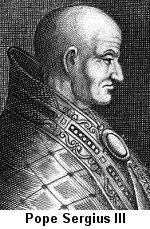
Pope Sergius
III (904-911) obtained the Papal office by murder. The
annals of the church of Rome tell about his life of open sin with
Marozia who bore him several illegitimate children. He was
described by Baronius as a "monster" and by Gregorovius as a
"terrorizing criminal." Says a historian: "For seven years
this man ... occupied the chair of St.Peter, while his concubine
and her like mother held court with a pomp and voluptousness that
recalled the worse days of the ancient empire."
This
woman - Theodora - likened to Semiramis (because of her corrupt
morals), along with Marozia, the Pope's concubine, "filled the
papal chair with their paramours and bastard sons, and turned the
Papal palace into a den of robbers." The reign of Pope
Sergius III began the period known as "the rule of the harlots"
(904-963).
.
Pope John
X (914-928) originally had been sent to Ravanna as an archbishop,
but Theodora had him returned to Rome and appointed to the Papal
office. According to Bishop Liutprand of Cremona who wrote a
history about fifty years after this time, "Theodora supported
John's election in order to cover more easily her illicit
relations with him." His reign came to a sudden end when
Marozia smothered him to death! She wanted him out of the
way so Leo VI (928-929) could become Pope. His reign was a
short one, however, for he was assassinated by Marozia when she
learned he had "given his heart to a more degraded woman than
herself"!
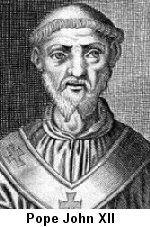
Not long
after this, the teenage son of Marozia - under the name of John XI
- became Pope. The Catholic Encyclopedia says, "Some, taking
Liutprand and the 'Liber Pontificalis' as their authority, assert
that he was the natural son of Sergius III (a former Pope).
Through the intrigues of his mother, who ruled at that time in
Rome, he was raised to the Chair of Peter." But in
quarreling with some of his mother's enemies, he was beaten and
put into jail where he died from poisoning.
In 955
the grandson of Marozia at eighteen years of age became Pope under
the name of John XII. The Catholic Encyclopedia describes him as
"a coarse, immoral man, whose life was such that the Lateran was
spoken of as a brothel, and the moral corruption in Rome became
the subject of general odium ... On 6 November a synod composed of
fifty Italian bishops was convened in St.Peter's; John was
accused of sacrilege, simony, perjury, murder, adultery, and
incest, and was summoned in writing to defend himself. Refusing to
recognize the synod, John pronounced sentence of excommunication
against all participators in the assembly, should they elect in
his stead another Pope ... John XII took bloody vengeance on the
leaders of the opposite party, Cardinal-Deacon John had his right
hand struck off, Bishop Otgar of Speyer was scourged, a high
palatine official lost nose and ears ... John died on 14 May, 964,
eight days after he had been, according to rumor, stricken by
paralysis in the act of adultery."
The noted
Catholic Bishop of Cremona, Luitprand, who lived at this time
wrote: "No honest lady dared to show herself in public, for Pope
John had no respect either for single girls, married women, or
widows - they were sure to be defiled by him, even on the tombs of
the holy apostles, Peter and Paul." The Catholic collection of the
lives of Popes, the "Liber Pontificalis," said: "He spent his
entire life in adultery."
Pope
Boniface VII (984-985) maintained his position through a lavish
distribution of stolen money. The Bishop of Orleans referred
to him (and also John XII and Leo VIII) as "monsters of guilt,
reeking in blood and filth" and as "antichrist sitting in the
temple of God." The Catholic Encyclopedia says he: "overpowered
John XIV (April, 984), thrust him into the dungeons of Sant
Angelo, where the wretched man died four months later ...For more
than a year Rome endured this monster steeped in the blood of his
predecessors. But the vengeance was terrible. After his
sudden death in July, 985, due in all probability to violence, the
body of Boniface was exposed to the insults of the populace,
dragged through the streets of the city, and finally, naked and
covered with wounds, flung under the statue of Marcus Aurelius ...
The following morning compassionate clerics removed the corpse and
gave it a Christian burial."
Next came
Pope John XV (985-996) who split the church's finances among his
relatives and earned for himself the reputation of being "covetous
of filthy lucre and corrupt in all his acts."
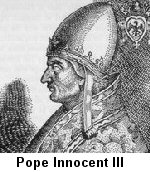
Benedict
VIII (1012-1024) "bought the office of Pope with open
bribery." The following Pope, John XIX also bought the
Papacy. Being a layman, it was necessary for him to be
passed through all the clerical orders in one day! After
this, Benedict IX (1033-1045) was made Pope as a youth 12 years
old (or some accounts say 20) through a money bargain with the
powerful families that ruled Rome! He "committed murders and
adulteries in broad daylight, robbed pilgrims on the graves of the
martyrs, a hideous criminal, the people drove him out of Rome. The
Catholic Encyclopedia says, "He was a disgrace to the Chair of
Peter."
"Simony"
the buying and selling of the Papal office became so common, and
corruption so pronounced, that secular rulers stepped in. King
Henry III appointed Clement II (1046-1047) to the office of Pope
"because no Roman clergyman could be found who was free of the
pollution of simony and fornication."
A number
of the Popes had committed murders, but Innocent III (1198-1216)
surpassed all of his predecessors in killing. Though he did
not do the killing personally, he promoted the most devilish thing
in human history - the Inquisition. Estimates of the number
of heretics that Innocent (not so innocently) had killed run as
high as one million people! For over five hundred years, Popes
used the inquisition to maintain their power against those who did
not agree with the teachings of the Roman
church.
In
conflicts with cardinals and kings, numerous charges were brought
against Pope Boniface VIII (1294-1303). Says The Catholic
Encyclopedia, "Scarcely any possible crime was omitted -
infidelity, heresy, simony, gross and unnatural immorality,
idolatry, magic, loss of the Holy Land, death of Celestine V, etc.
... Protestant historians, generally, and even modern Catholic
writers - class him among the wicked Popes, as an ambitious,
haughty, and unrelenting man, deceitful also and treacherous, his
whole pontificate one record of evil. " It is not necessary
to insist that all charges brought against him were true, but all
cannot be dismissed either. During his reign the poet Dante
visited Rome and described the Vatican as a "sewer of
corruption." He assigned Boniface (along with Popes Nicolas
III and Clement V) to "the lower parts of hell."
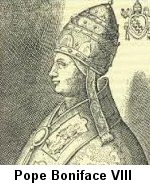
Though
seeking to put emphasis on certain good traits of Boniface,
"Catholic historians ... admit, however, the explosive violence
and offensive phraseology of some of his public documents."
An example of this "offensive phraseology" would be his statement
that "to enjoy oneself and to lie carnally with women or with boys
is no more a sin than rubbing one's hands together." On
other occasions, apparently in those "explosive" moments he called
Christ a "hypocrite" and professed to be an atheist.
Yet - and
this sounds almost unbelievable - it was this Pope that in 1302
issued the well-known "Unam Sanctum" which officially declared
that the Roman Catholic Church is the only true church, outside of
which no one can be saved, and says: "We, therefore, assert,
define and pronounce that it is necessary to salvation to believe
that every human being is subject to the Pontiff of Rome."
Because there
have been sinful Popes, being "subject" to the Pope has raised a
question. Should a sinful Pope still be obeyed? The Catholic
answer is this: "A sinful Pope ... remains a member of the
(visible) church and is to be treated as a sinful, unjust ruler
for whom we must pray, but from whom
we may not withdraw our
obedience."
From 1305
to 1377 the Papal palace was at Avignon, France. During this
time, Petrarch accused the Papal household of "rape, adultery, and
all manner of fornication." In many parishes men insisted on
priests keeping concubines "as a protection for their own
families!
During
the Council of Constance, three Popes, and sometimes four, were
every morning cursing each other and calling their opponents
antichrists, demons, adulterers, sodomists, enemies of God and
man. One of these "Popes", John XXIII (1410-1415) "was accused by
thirty seven witnesses (mostly, bishops and priests) of
fornication, adultery, incest, sodomy, simony, theft, and
murder! It was proved by a legion of witnesses that he had
seduced and violated three hundred nuns. His own secretary,
Niem, said that he had at Boulogne, kept a harem, where not less
than two hundred girls had been the victims of his
lubricity." Altogether the Council charged him with
fifty-four crimes of the worst kind.
A Vatican
record offers this information about his immoral reign. "His
lordship, Pope John, committed perversity with the wife of his
brother, incest with holy nuns, intercourse with virgins, adultery
with the married, and all sorts of sex crimes...wholly given to
sleep and other carnal desires, totally adverse to the life and
teaching of Christ ... he was publicly called the Devil
incarnate." To increase his wealth. Pope John taxed
about everything - including prostitution, gambling, and usury. He
has been called "the most depraved criminal who ever sat on the
papal throne."
Pope Pius
II (1458-1464) was said to have been the father of many
illegitimate children. He "spoke openly of the methods he
used to seduce women, encouraged young men to, and even offered to
instruct them in methods of, self-indulgence." Pius was
followed by Paul 11 (1464-1471) who maintained a house full of
concubines. His Papal tiara outweighed a palace in its
worth.
Next came
Pope Sixtus IV (1471-1484) who financed his wars by selling church
offices to the highest bidders and "used the papacy to enrich
himself and his relatives. He made eight of his nephews
cardinals, while as yet some of them were mere boys. In
luxurious and lavish entertainment, he rivaled the Caesars.
In wealth and pomp he and his relatives surpassed the old Roman
families."
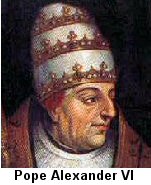
Pope Innocent
VIII (1484-1492) was the father of sixteen children by various
women. Some of his children celebrated their marriages in
the Vatican. The Catholic Encyclopedia mentions only "two
illegitimate children, Franceschetto and Teodorina" from the days
of a "licentious youth." Like numerous other popes, he multiplied
church offices and sold them for vast sums of money. He permitted
bull fights on St.Peter's square.
Next came
Rodergio Borgia who took the name of Alexander VI (1492-1503),
having won his election to the papacy by bribing the cardinals.
Before becoming Pope, while a cardinal and archbishop, he lived in
sin with a lady of Rome, Vanozza dei Catanei; and afterward, with
her daughter Rosa, by whom he had five children, On his coronation
day, he appointed his son - a youth of vile temper and habits - as
archbishop of Valencia. Many consider Alexander VI to be the
most corrupt of the Renaissance Popes. He lived in public
incest with his two sisters and his own daughter, Lucretia, from
whom, it is said, he had a child. On October 31, 1501, he
conducted a sex orgy in the Vatican, the equal of which or sheer
horror has never been duplicated in the annals of human history.
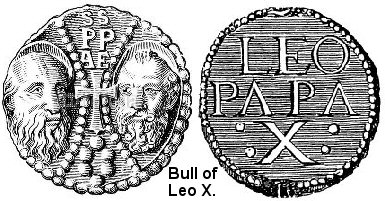
Pope Leo X
(1513-1521) was born December 11, 1475. He received tonsure at age
7, was made an abbot at 8, and a cardinal at 13! The
Catholic Encyclopedia says that Pope
Leo X "gave himself up unrestrainedly to amusements that
were provided in lavish abundance. He was possessed by an
insatiable love of pleasure ...He loved to give banquets and
expensive entertainments, accompanied by revelry and
carousing." The picture given here shows the Bull of Pope Leo X. On
one side of the leaden seal appears the apostles Peter and Paul,
on the other the popes name and title. The word "bull" (from a Latin word
linked with roundness) was first applied to the seals which
authenticated papal documents and later to the documents
also. Today we commonly use the word "bulletin" which stems
from the same source.
According
to "Life" magazine, Pope Paul III (1534-1549) as cardinal had
fathered three sons and a daughter. On the day of his
coronation he celebrated the baptism of his two
great-grandchildren. He appointed two of his teenage nephews
as cardinals, sponsored festivals with singers, dancers, and
jesters, and sought advice from astrologers.
During
those days, Martin Luther, while still a priest of the papal
church, traveled to Rome. As he caught the first glimpse of
the seven-hilled city, he fell to the ground and said: "Holy Rome,
I salute thee." He had not spent much time there, however,
until he saw that Rome was anything but a holy city.
Iniquity existed among all classes of the clergy. Priests
told indecent jokes and used awful profanity, even during
Mass. The Papal court was served at supper by twelve naked
girls. "No one can imagine what sins and infamous actions
are committed in Rome," he said, "they must be seen and heard to
be believed. Thus they are in the habit of saying, 'If there
is a hell, Rome is built over it'."
One day
during Luther's visit to Rome, he noticed a statue on one of the
public streets that led to St.Peter's - the statue of a female
Pope. Because it was an object of disgust to the Popes, no Pope
would ever pass down that certain street. "I am astonished", said
Luther, "how the Popes allow the statue to remain." Forty
years after Luther's death, the statue was removed by Pope Sixtus
V.
Though
The Catholic Encyclopedia regards the story of Pope Joan as a mere
tale, it gives the following summary: "After Leo IV (847-855) the
Englishman John of Mainz occupied the Papal chair two years, seven
months and four days, he was, it is alleged, a woman. When a
girl, she was taken to Athens in male clothes by her lover, and
there made such progress in learning that no one was her
equal. She came to Rome, where she taught science, and
thereby attracted the attention of learned men - and was finally
chosen as Pope, but, becoming pregnant by one of her trusted
attendants, she gave birth to a child during a procession from
St.Peter's to the Lateran - There she died almost immediately, and
it is said she was buried at the same place."
Was there
really a female Pope? Prior to the Reformation which exposed so
much error in the Romish church, the story was believed by
chroniclers, bishops, and by Popes themselves. The Catholic
Encyclopedia says, "In the fourteenth and fifteenth centuries this
Popess was already counted as an historical personage, whose
existence no one doubted. She had her place among the carved
busts which stood in Siena cathedral. Under Clement VII
(1592-1595), and at his request, she was transformed into Pope
Zacharias. The heretic Hus, in defence of his false doctrine
before the Council of Constance, referred to the Popess, and no
one offered to question the fact of her existence." Some
have questioned how Pope Clement could have a female Pope, named
Joan, "transformed" into a male Pope, named Zacharias, centuries
after she had died!
Having
mentioned the gross immorality that has existed in the lives of
some of the Popes, we do not wish to leave the impression that all
Popes have been as bad as the ones mentioned. But we do
believe this evidence seriously weakens the doctrine of "apostolic
succession", the claim that the Roman Catholic Church is the one
true church because it can trace a line of Popes back to
Peter. Is this really an important point? If so, each
of these Popes, even those who were known to be immoral and cruel,
must be included. There is even the possibility of a female
Pope to make the succession complete! But salvation is not
dependent on tracing a line of Popes back to Peter - or even on a
system of religion claiming to represent Christ. Salvation is found in Christ himself.
 Pope Sergius
III (904-911) obtained the Papal office by murder. The
annals of the church of Rome tell about his life of open sin with
Marozia who bore him several illegitimate children. He was
described by Baronius as a "monster" and by Gregorovius as a
"terrorizing criminal." Says a historian: "For seven years
this man ... occupied the chair of St.Peter, while his concubine
and her like mother held court with a pomp and voluptousness that
recalled the worse days of the ancient empire."
Pope Sergius
III (904-911) obtained the Papal office by murder. The
annals of the church of Rome tell about his life of open sin with
Marozia who bore him several illegitimate children. He was
described by Baronius as a "monster" and by Gregorovius as a
"terrorizing criminal." Says a historian: "For seven years
this man ... occupied the chair of St.Peter, while his concubine
and her like mother held court with a pomp and voluptousness that
recalled the worse days of the ancient empire."


 Pope Innocent
VIII (1484-1492) was the father of sixteen children by various
women. Some of his children celebrated their marriages in
the Vatican. The Catholic Encyclopedia mentions only "two
illegitimate children, Franceschetto and Teodorina" from the days
of a "licentious youth." Like numerous other popes, he multiplied
church offices and sold them for vast sums of money. He permitted
bull fights on St.Peter's square.
Pope Innocent
VIII (1484-1492) was the father of sixteen children by various
women. Some of his children celebrated their marriages in
the Vatican. The Catholic Encyclopedia mentions only "two
illegitimate children, Franceschetto and Teodorina" from the days
of a "licentious youth." Like numerous other popes, he multiplied
church offices and sold them for vast sums of money. He permitted
bull fights on St.Peter's square.